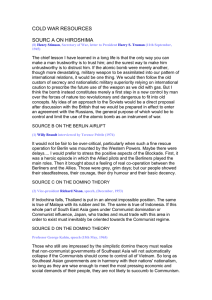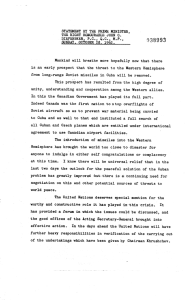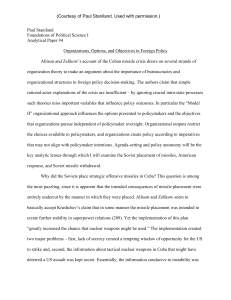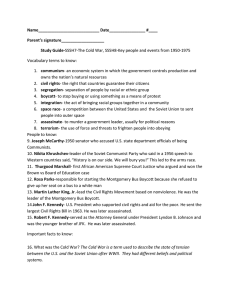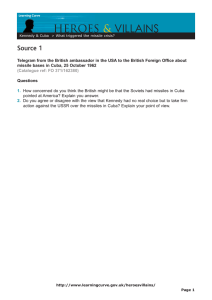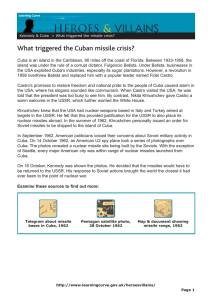(Courtesy of Caitlin Talmadge. Used with permission.) Caitlin Talmadge
advertisement
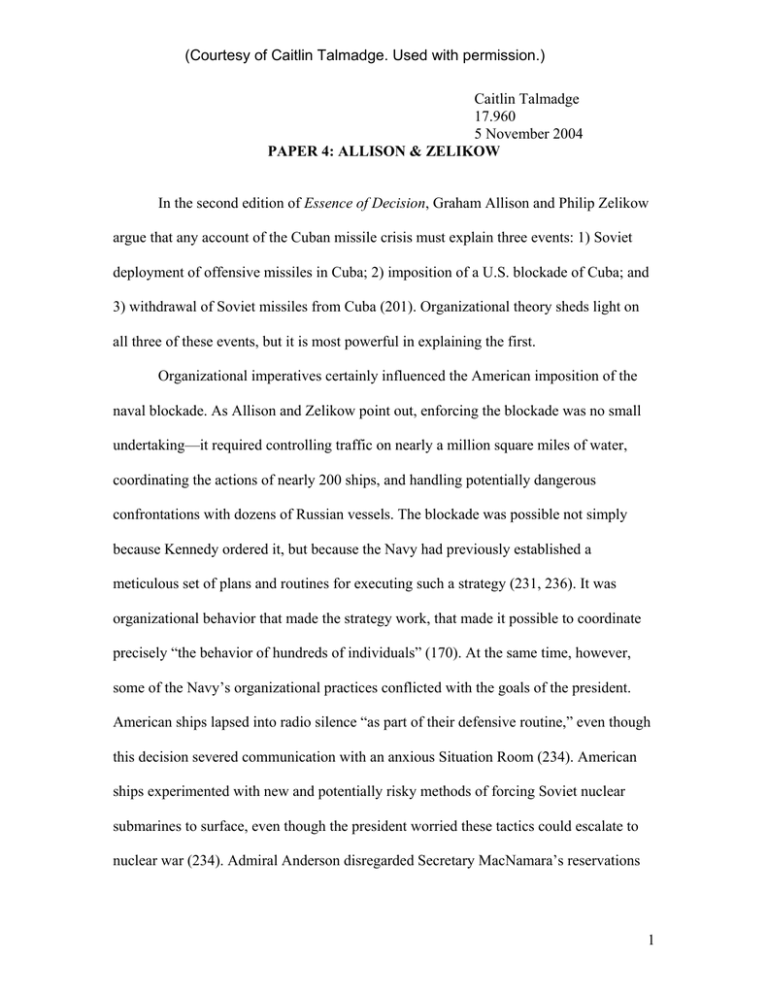
(Courtesy of Caitlin Talmadge. Used with permission.) Caitlin Talmadge 17.960 5 November 2004 PAPER 4: ALLISON & ZELIKOW In the second edition of Essence of Decision, Graham Allison and Philip Zelikow argue that any account of the Cuban missile crisis must explain three events: 1) Soviet deployment of offensive missiles in Cuba; 2) imposition of a U.S. blockade of Cuba; and 3) withdrawal of Soviet missiles from Cuba (201). Organizational theory sheds light on all three of these events, but it is most powerful in explaining the first. Organizational imperatives certainly influenced the American imposition of the naval blockade. As Allison and Zelikow point out, enforcing the blockade was no small undertaking—it required controlling traffic on nearly a million square miles of water, coordinating the actions of nearly 200 ships, and handling potentially dangerous confrontations with dozens of Russian vessels. The blockade was possible not simply because Kennedy ordered it, but because the Navy had previously established a meticulous set of plans and routines for executing such a strategy (231, 236). It was organizational behavior that made the strategy work, that made it possible to coordinate precisely “the behavior of hundreds of individuals” (170). At the same time, however, some of the Navy’s organizational practices conflicted with the goals of the president. American ships lapsed into radio silence “as part of their defensive routine,” even though this decision severed communication with an anxious Situation Room (234). American ships experimented with new and potentially risky methods of forcing Soviet nuclear submarines to surface, even though the president worried these tactics could escalate to nuclear war (234). Admiral Anderson disregarded Secretary MacNamara’s reservations 1 and insisted on tracking a Soviet submarine several hundred miles from the quarantine line, because “it was just part of the overall naval strategy and … in such situations it was a common Navy practice to ‘trail’ unidentified submarines” (236). In each of these cases, the Navy’s—or “America’s”—behavior was either inconsistent with the country’s stated goals or actually increased the possibility that the crisis would escalate. Yet, there was little that the top-level political leadership could do to change the behavior of the very organization whose routines and procedures were also needed to make the strategy succeed. Organizational theory also illuminates some aspects of the Soviet withdrawal of missiles from Cuba, although much of Allison and Zelikow’s interesting analysis under this heading is not actually about the resolution of the crisis. It is true, though, that Khrushchev’s frustration with the cumbersome processes of formal interstate communication led him to make his famous second offer on the radio, instead of in private (239-240). What American leaders saw as a bad faith gesture designed to complicate their negotiating position was instead a Soviet leader’s attempt to overcome the organizational routines of his own bureaucracy. Kennedy experienced some similar frustrations with the State Department, which did not respond promptly to his directive to “undertake private discussion with the Turks that would prepare the way to respond effectively to Khrushchev’s predictable maneuver” (241). Following the organizational tendency to “interpret mandates in their own terms,” the State Department read Kennedy’s order as an opportunity to advance its own negotiating agenda with Turkey. It also failed to register the urgency of the situation, leading to the inexplicably 2 “formalized, sluggish,” and “inappropriate” behavior that Allison and Zelikow argue organizations tend to produce (170). Organizational theory sheds the most light on Soviet actions in Cuba. One can certainly interpret the emplacement of missiles there as Krushchev’s attempt to force a showdown over Berlin (203). And yet, many Soviet decisions in the summer and fall of 1962 did not seem to further this goal, and in some cases even made it more difficult to achieve. For example, the USSR seemed not to anticipate the possibility of U2 observance of its actions in Cuba, even though the USSR was well aware of U2 photographic capability and its use for surveillance of nuclear sites in the USSR (206). The USSR did not shoot down the initial U2 flight on October 14, even though it had functioning surface-to-air missiles (SAMs) installed in Cuba at the time (207). The USSR made no attempt to camouflage its activities until the United States publicly disclosed its knowledge of the Soviet buildup in Cuba (207-8). The “sites constructed in Cuba were built to look exactly like the SAM, MRBM, and IRBM sites in the Soviet Union,” which enabled American analysts to identify them easily (208). Most important, the strategic character of the nuclear missiles placed in Cuba was nonsensical. The sites were extremely soft, that is, vulnerable to a first strike, and the Soviets “transported an extra ballistic missile for each pair of launchers,” so that a launcher could be reloaded and a second “nuclear salvo” could be fired from each missile site (209). Yet the Cuban missiles could hope to fire twice only if the United States was caught by complete surprise and had never discovered the sites—in which case, how could the sites have been used as a bargaining chip over Berlin? Under all reasonable scenarios, a third of the missiles the Soviets had painstakingly transported to Cuba would never be fired (209). 3 These seemingly bizarre decisions make sense only when evaluated as the products of Soviet organizations transporting their methods 8,000 miles to a foreign island. For example, it was the lack of a standard operating procedure for creating camouflage that led the workers in Cuba to avoid it in favor of what they considered their “critical task”—constructing the missiles (168- 169). According to Allison and Zelikow, “a serious effort to camouflage the operation was possible” if the workers had been willing to adapt to the conditions of the island. “But the units constructing the missiles had no routine for camouflage, having never camouflaged construction in the Soviet Union” (213). So they chose not to. Similarly, as a Soviet general explained, the SAM operators did not fire on the U2 because “Moscow had sent them to Cuba to defend against air attack, not aerial espionage” (214). Again, the organization chose not to deviate from the “objectives most congruent to [its] special capacities” (167, 177), and in fact did not even turn on its radars to track spy planes (214). Meanwhile, the easily identifiable pattern of missile construction and the puzzling strategic character of the weapons placed in Cuba reflected the Strategic Rocket Forces’ reliance on its own programs and repertoires (170). “At the sites, each team did what it knew how to do… At each IRBM site, the two pairs of identical launchers were separated by 750 feet,” because that was the distance between IRBM sites in the Soviet Union. “An extra missile was transported for each pair of launchers because … refire capability… was part of their usual deployment in the western Soviet Union, aimed at Western Europe.” The missile sites were left vulnerable, “not because of any intention to launch a first strike, but rather because no Soviet missile sites had ever been hardened” (212). Over and over, Soviet actions in Cuba that seemed anomalous or outright inconsistent with “rational” Soviet 4 interests appear predictable and logical in light of organization theory. The organizations were operating according to a “logic of appropriateness”—“a matching of rules to situations”—rather than a “logic of consequences,” which would require choosing actions by “evaluating their probable consequences for the preferences of the actor” and engaging in a “selective, heuristic search among alternatives” to devise a solution (146). WORD COUNT 1244 5

